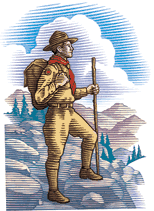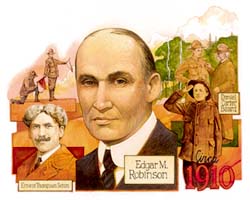Scouting--October 1998

The BSA's 'forgotten' founding father

By Robert Peterson
Illustration by Joel Snyder
Although he didn't carry the title of Chief Scout
Executive, a veteran YMCA boys'-work executive named Edgar M. Robinson
served as the head of the new Boy Scouts of America during the organization's
struggling first year.
Ask veteran Scouters to name the founders of Scouting, and chances are they
will name Robert S. S. Baden-Powell, the British war hero who launched the Boy
Scout movement in England in 1908.
Maybe they'll mention Ernest Thompson Seton or Daniel Carter Beard, both naturalists,
artists, and riveting speakers who led separate boys' organizations in the United
States that joined the Boy Scouts of America when the BSA was born in 1910.
Scouters might also bring up the name of James E. West, who was Chief Scout
Executive for 32 years. Possibly they will mention William D. Boyce, the Chicago
publisher who incorporated the BSA on Feb 8, 1910, after learning about Scouting
during his famous "foggy" visit to London.
Not a charismatic figure
 But rarely, if ever, will they mention the name of Edgar M. Robinson. A forgotten
member of Scouting's "founding fathers," Robinson was an executive with the Young
Men's Christian Association who helped get the BSA through most of its first year
without a stumble.
But rarely, if ever, will they mention the name of Edgar M. Robinson. A forgotten
member of Scouting's "founding fathers," Robinson was an executive with the Young
Men's Christian Association who helped get the BSA through most of its first year
without a stumble.
He was the balding, 43-year-old boys'-work secretary of the YMCA's International
Committee which governed Ys in the United States and Canada.
When the BSA was founded in 1910, 400 local YMCA summer camps were serving 15,000
boys. E. M. Robinson, a native of Canada, was a veteran camp director with 20 years'
experience in youth work.
In his portrait photo, the balding, 43-year-old Robinson looks stiff and starchy like
the professor he was in his latter years at Springfield (Mass.) College, the YMCA's
training center.
He wasn't like that at all, according to Laura Jo Wechwerch Judd, who remembers Robinson
from her girlhood as a professor's daughter.
"He was tall, very dignified, and he loved the outdoors," said Ms. Judd, now a retired
faculty member herself. "He had a wonderful, sunny disposition. He was very formal, but
outdoors he was a whole different person."
But E. M. Robinson was well aware of the fact that he was not a charismatic figure like
Ernest Thompson Seton or Dan Beard. It was said that he despaired on his first visit to
a YMCA camp when he saw leaders enthralling boys by being fatherly, leading them in song,
or convulsing them with laughter.
Robinson thought to himself, There is no hope for me to be a leader of boys for I am
not musical, witty, or fatherly. But then, the story goes, a still, small voice said
to him, "Perhaps God can use all varieties of men, perhaps even me."
With that happy thought, E. M. Robinson immersed himself in work with boys. In 1900 he
became the first boys'-work secretary of the Y's International Committee, with headquarters
in New York City.
A visit to Chicago
Naturally, Robinson was interested when he began hearing reports in 1908 and '09 about
the new Boy Scout movement in England. A few YMCAs set up troops, and some Y camps were
using elements of the Scoutcraft skills being taught in Britain.
So when Robinson heard in early May 1910 that William D. Boyce had incorporated the Boy
Scouts of America months earlier, he was alarmed. The news meant that Boyce controlled
the Boy Scouts and the future of the movement in America.
With two other YMCA men, he hastened to Chicago to visit with the publisher. There
they learned that while Boyce had title to the BSA name, he had no boys and no
organization.
E. M. Robinson turned on the charm. He urged Boyce to throw in his lot with the YMCA,
which could serve as the point organization for setting up Scouting--and could also
provide a source of Scoutmasters.
Boyce was sold. He even agreed to give $1,000 a month to get the BSA on its financial
feet.
Robinson hustled back to New York. In short order, he set in motion the process that
would lead to transfer of title from Boyce to an as-yet-unformed national committee.
Something had to be done
On June 1 Robinson opened a one-room national office for the Boy Scouts of America right
next to his own office in the YMCA building on East 28th Street. He persuaded John M.
Alexander, a YMCA boys'-work secretary in Philadelphia, to run the office, with a
stenographer as the lone staff member.
Through his camping experiences, Robinson was a friend of Ernest Thompson Seton, and he
invited Seton to merge his Woodcraft Indians into the BSA. Seton and Robinson then
approached men who had announced plans for their own Scouting organizations and got all
but one of them--the publisher William Randolph Hearst--to come into the BSA.
Correspondence was soon pouring into the tiny office from men and boys who wanted to start
troops. Years later Robinson remembered, "Unopened letters were at times stacked like
cordwood on the floor."
Something had to be done. Robinson's response was to call a meeting for June 15 of
prominent men who were involved in working with boys. That was followed six days later
by another meeting, at which a committee was appointed to organize the BSA's National
Committee. Seton was named chairman.
Historic camp on Lake George
While the committee deliberated, a historic two-week Scout camp was held at Silver Bay
on Lake George in upstate New York.
As organized a year earlier, the camp wasn't intended to be a Scouting experience.
Robinson had originally arranged for Ernest Thompson Seton to demonstrate Woodcraft
Indians campcraft at a special late August session for YMCA boys.
As it turned out, Seton and all the other camp leaders were involved with the infant
Boy Scouts of America. They taught the campers about Scouting as well as the Woodcraft
Indians. Even though all participants were YMCA boys and leaders, they became part of
what is recognized as the first Scout camp in America.
By the time the camp ended Sept. 1, "troops of Scouts were springing up like mushrooms
in every section of the country," Robinson wrote. That fall, he recruited a financial
secretary to solicit funds for the BSA and began looking for his own successor as
executive secretary.
Recruiting a legend
E. M. Robinson declined overtures to become the BSA's permanent executive secretary because,
he said, "my attachment to the YMCA was too strong to allow me to consider it."
His attention was called to an enterprising young lawyer in Washington, D.C., named James
E. West. West had been active in the Y, the playground movement, and the Child Rescue League,
and Robinson tried to recruit him for the BSA.
At first West resisted Robinson's entreaties to take the helm of the financially shaky
movement. But he finally accepted the challenge and started work as the BSA's new chief on
Jan. 1, 1911. He was a firm hand on the tiller until 1943.
E. M. Robinson remained the preeminent figure in YMCA boys' work until his retirement in
1927. He died in 1951; by then, his brief, but vital, role in putting the BSA on a firm
foundation had been all but forgotten.
Scouting magazine contributing editor Robert Peterson also wrote "The Training of Pioneer
Scout Leaders" in the September 1998 The Way It Was column.
Top of Page
 But rarely, if ever, will they mention the name of Edgar M. Robinson. A forgotten
member of Scouting's "founding fathers," Robinson was an executive with the Young
Men's Christian Association who helped get the BSA through most of its first year
without a stumble.
But rarely, if ever, will they mention the name of Edgar M. Robinson. A forgotten
member of Scouting's "founding fathers," Robinson was an executive with the Young
Men's Christian Association who helped get the BSA through most of its first year
without a stumble.